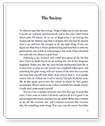Essay Instructions: This paper has 3 (three) parts. Each part should be approximately 500 words. Multiple sources are NOT necessary.
Part #1
Over half of the nation’s lettuce comes from three California areas: the Imperial Valley in the southeastern corner of the state, the area centered around Huron in FresnoCounty, and the area around Salinas in MontereyCounty. The Imperial Valley harvests in the late fall, Huron in the spring, and Salinas in the late spring and summer. Arizona, because of its warm weather, ships lettuce during the winter months.
In early 2002, the following events converged to bring the highest lettuce prices (about $3 per head) for Californians in 15 years:
•Unusually cold winter weather stunted Arizona’s lettuce crop.
•The cold, to a lesser extent, also hit the Imperial Valley.
•At the same time, the East Coast had an unusually mild winter, which kept shipping routes open and demand for lettuce high.
•According to the Department of Agriculture officials, about 6 percent less lettuce was planted at this time than in the year before.
•In about four weeks, it was expected that Arizona’s stunted crops would recover and at the same time, Huron’s fields would be ready for harvest, resulting in a double harvest.
Source: “Shortage Drives Lettuce Price Up, Sacramento Bee, March 15, 2002, p. D2 (Reprinted from the Associated Press).
Describe what shift factors of supply and/or demand might be at work and how you would label those factors. Conclude the report with your forecast of what would likely result one month after the publication of the article.
Part #2
Folk wisdom has it that when people lose their jobs, they drown their sorrows in drink. Economists have long challenged this assumption citing two reasons:
· Overall consumption of alcohol does not increase during recessions.
· Falling incomes during a recession make it harder to people to increase their purchases of booze.
Two economists took a close look at a broad survey of more than 50,000 persons each year from 1987 to 1999. They found that drinkers do reduce their consumption substantially in economic downturns.
· A one-percentage-point increase in unemployment in a state decreased alcohol consumption by drinkers by more than 3 percent.
· A one-percentage-point rise in the national unemployment rate decreased alcohol consumption by 4 percent.
Source: “Out of Work and in the Bar?” Business Week, November 12, 2001, p. 36.
Questions:
1. Explain why it i s or is not possible to calculate the elasticity of demand for alcohol consumption for the state situation?
2. Explain why it is or is not possible to calculate the elasticity of demand for alcohol consumption for the federal situation.
3. Were the demands calculated above elastic or inelastic?
4. Do you think that alcohol abuse will become such an increasing problem during recessions that would cause some government action to take place?
Part #3
Two professors from the University of Michigan offered a paper entitled “Dying to Save Taxes: Evidence From Estate Tax Returns on the Death Elasticity,” published by the National Bureau of Economic Research. It asked the rather ghoulish question of whether people can time their death to take advantage of changes in the estate tax.
This is hard evidence that taxes are great motivators in economic decisions.
· Whether to buy stocks or bonds
· When to realize capital gains or exercise a stock option.
· Deciding on how many hours to work if you are paid by the hour.
· How much to save and how much to invest.
· Whether to sign up for additional training or to take entrepreneurial risks.
There is also evidence that taxes are motivators in quasieconomic decisions.
· Since the penalty for being married increases across a year, fewer people marry in November and December relative to those who marry in the spring.
· This is also true for the timing of births. More babies are born during the last week in December than the first week in January.
Special occasions are also great motivators for the timing of death.
· People postpone their deaths to mark another birthday or anniversary.
· Some people want to live long enough to celebrate holidays. Among Jews, the number of deaths is lower before Passover and higher during the week thereafter.
· Death rates among the Chinese decrease during the week before the festival of the Harvest Moon and increase the week after.
· In New York City, 46 percent more persons died in the first week of the new millennium than in the last week of 1999.
So was it possible for these phenomena to be brought together? Would people time their deaths so that their heirs could realize benefits coming from changes in the estate tax?
“The economists found that a $1,000 tax saving increases the probability of dying just before a tax increase by 1 percent, while the same amount of saving increases the probability of dying just after a tax decrease by almost 2.5 percent. In other words, they not only found a behavioral response to changes in estate taxes, but they found that the response to tax cuts was stronger than it was to tax increases.”
Source: Susan Lee, “Death and Taxes,” The Wall Street Journal, June 1, 2001, p. A14.
Questions:
1. What is the cost to government for imposing the estate tax?
2. What is the cost to the taxpayer for imposing the estate tax on him?
3. Does this case have anything to do with the ability-to-pay principle?
4. Does this case have anything to do with the benefit principle?
5. Is the person(s) who pay the tax different from the person who bears the burden of the tax?


